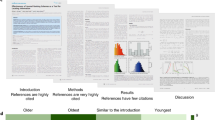Abstract
The senior author is usually last on the byline of scientific publications, yet generally has made the second most important contribution. The explosion in author number per scientific paper, has necessitated limits on the number of authors allowed in cited references, frequently resulting in senior author truncation. Would potential visibility gained from citations in top-tier journals be offset by senior author omission? We found evidence for this in a sample of 208 journals, showing significant associations between author limits in cited references and various measures of journal quality. These associations, however, differed among biological science, physical science, and interdisciplinary journals.
Similar content being viewed by others
References
Amin, M., Mabe, M. (2000), Impact factors: Use and abuse. Perspectives in Publishing, 1: 1–6.
Bennett, D. M., Taylor, D. M. (2003), Unethical practices in authorship of scientific papers. Emergency Medicine, 15: 263–270.
Bhandari, M., Busse, J. W., Kulkarni, A. V., Devereaux, P. J., Leece, P., Guyatt, G. H. (2004), Interpreting authorship order and corresponding authorship. Epidemiology, 15: 125–126.
Burman, K. D. (1982), Hanging from the masthead? Reflections on authorship. Annals of Internal Medicine, 97: 602–605.
Conover, W. J., Iman, R. L. (1981), Rank transformation as a bridge between parametric and nonparametric statistics. The American Statistician, 35: 124–129.
Drenth, J. P. H. (1998), Multiple authorship: The contribution of senior authors. Journal of the American Medical Association, 280: 219–221.
Epstein, R. J. (1993), Six authors in search of a citation: villains or victims of the Vancouver convention? British Medical Journal, 306: 765–767.
Garfield, E. (2006), The history and meaning of the journal impact factor. Journal of the American Medical Association, 295: 90–93.
Hoeffel, C. (1998), Journal impact factors. Allergy, 53: 1225.
Institute for Scientific Information, (2004), Journal Citation Reports, Science Edition, http://portal.isiknowledge.com Accessed October, 2004.
ISI Web of Science (2004), Crowd control? Multiauthor papers appear to level off in recent years. Science Watch, 15(4): 1–3.
International Committee of Medical Journal Editors (1993), Uniform requirements for manuscripts submitted to biomedical journals. Journal of the American Medical Association, 269: 2282–2286.
Kennedy, D. (2003), Multiple authors, multiple problems. Science, 301: 733.
Monastersky, R. (2005), The number that’s devouring science. Chronicle of Higher Education, 52: A12–A17.
Newman, M. E. J. (2004), Coauthorship networks and patterns of scientific collaboration. Proceedings of the National Academy of Science, 101: 5200–5205.
Peffers, K., Hui, W. (2003), Collaboration and author order: Changing patterns in IS research. Communications of AIS, 11: 2–19.
Reisenberg, D., Lundberg, G. D. (1990), The order of authorship: Who’s on first? Journal of the American Medical Association, 264: 1857.
Rennie, D., Yank, V., Emanuel, L. (1997), When authorship fails: A proposal to make contributors accountable, Journal of the American Medical Association, 278: 579–585.
Savitz, D. A. (1999), What can we infer from author order in epidemiology? American Journal of Epidemiology, 149: 401–403.
Shapiro, D. W., Wenger, N. S., Shapiro, M. F. (1994), The contributions of authors to multiauthored biomedical research papers. Journal of the American Medical Association, 271: 438–442.
The Serials Directory (2004), EBSCO, Birmingham, AL.
Ulrich’s International Periodicals Directory (2004), RR Bowker, New York, NY.
Weeks, W. B., Wallace, A. E., Kimberly, B. C. S. (2004), Changes in authorship patterns in prestigious US medical journals. Social Science and Medicine, 59: 1949–1954.
Whyte, W. H., Jr. (1957), The Organization Man, Doubleday & Co., Garden City, New York.
Author information
Authors and Affiliations
Corresponding author
Rights and permissions
About this article
Cite this article
Buehring, G.C., Buehring, J.E. & Gerard, P.D. Lost in citation: Vanishing visibility of senior authors. Scientometrics 72, 459–468 (2007). https://doi.org/10.1007/s11192-007-1762-4
Received:
Published:
Issue Date:
DOI: https://doi.org/10.1007/s11192-007-1762-4




